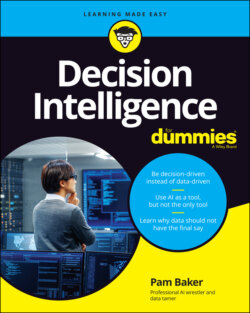Читать книгу Decision Intelligence For Dummies - Pamela Baker - Страница 51
Why data scientists and statisticians often make bad question-makers
ОглавлениеNot so long ago, data scientist was the hottest job on the market. Everyone was in pursuit of these data gurus to unleash the value of data and help drive companies forward. And data scientists did deliver what was asked of them. Unfortunately, many of their projects still failed because what they delivered wasn’t a match for expectations, although it usually was exactly as ordered. Organizations were and are notorious for not having a business plan in place for these initiatives from the start, and for not being precise in what they are asking data scientists to do.
In short, typically the data scientists didn’t fail. Ill-defined expectations and the lack of business planning rendered their work moot. But that’s not to say that data scientists’ work is always perfect either.
At first, data scientists had free rein, for no one else in the business could quite wrap their minds around this big data tsunami. They experimented with new big data tools to explore possibilities and to educate their businesses on how useful data analytics can be. Then they included projects to answer their business analysts’ and business users’ most often asked questions. They built dashboards and visualizations, automated them, scheduled regular releases of updated insights, and eventually advocated self-service business intelligence solutions to provide some user autonomy (within carefully structured limits, of course).
But the further this work progressed, the larger the gap typically became between the data scientists/data analysts crowd and the business managers/business executives crowd. That happens when data scientists have too little an understanding of the business and when business leaders have too little an understanding of data science.
As the data analytics industry has matured, businesses are finding that they have little appetite or budget for data projects that fall short of producing business value. The definition of a data-driven company has also changed — now it means that data has moved out of the driver’s seat and is riding shotgun. Data is an augmenter rather than a usurper.
By and large, data scientists are builders, and statisticians are largely data assemblers and interpreters. Data scientists and statisticians may still be building, assembling, and interpreting, but the problem is that almost everyone now has access to plenty of data tools — visualization tools and templates, model stores, sharable algorithms, specialized automation tools, AI in a box, and so on — to do those things in a more decentralized way. In addition, many of the queries data scientists and statisticians would come up with to ask of data now come prepackaged in modern, self-service business intelligence (BI) tools, complete with AI generated narratives in case the user has trouble interpreting the visualization correctly.
If you’re in one of these professions, no worries. There’s still plenty of work for data scientists and statisticians to do. But it does mean that the demand for new kinds of talent is rising. To borrow from Cassie Kozyrkov, Google’s chief decision scientist, if you were to think of data scientists as microwave builders, you’d realize that the world no longer needs any more microwaves — what it needs now are better microwave chefs.
In general, data scientists are tool and model builders, though statisticians are data wranglers and interpreters. Neither is a business decision maker. That’s not a slam on either profession but rather a clear delineation of job roles. It’s not entirely fair to blame either profession for failed projects if there was never a business plan to use their work anyway.
It’s time to focus on the science as well as the art of making decisions. Decision intelligence is about leveraging both hard and soft skills.
